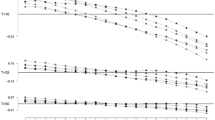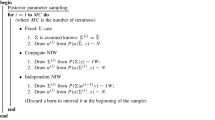Summary
It is well known that inference in vector autoregressive models depends crucially on the choice of lag-length. Various lag-length selection procedures have been suggested and evaluated in the literature. In these evaluations the possibility that the true model may have unequal lag-length has, however, received little attention. In this paper we investigate how sensitive lag-length estimation procedures, based on assumptions of equal or unequal lag-lengths, are to the true model structure. The procedures used in the paper are based on information criteria and we give results for AIC, HQ and BIC. In the Monte Carlo study we generate data from a variety of VAR-models with properties similar to macro-economic time-series. We find that the commonly used procedure based on equal lag-length together with AIC and HQ performs well in most cases. The procedure (due to Hsiao) allowing for unequal lag-lengths produce reasonable results when the true model has unequal lag-length. The Hsiao procedure tend to do better than equal lag-length procedures in models with a more complicated lag structure.
Similar content being viewed by others
References
Akaike, H. (1969), ‘Fitting autoregressive models for prediction’, Annals of the Institute of Mathematical Statistics 21, 243–247.
Akaike, H. (1974), ‘A new look at the statistical model identification’, IEEE Transactions on Automatic Control 19, 716–723.
Boswijk, P. & Franses, P. (1992), ‘Dynamic specification and cointegration’, Oxford Bulletin of Economics and Statistics 54, 369–380.
Cheung, Y. W. & Lai, K. (1993), ‘Finite-sample size of Johansen’s likelihood ratio test for cointegration’, Oxford Bulletin of Economics and Statistics 55, 313–328.
DeSerres, A. & Guay, A. (1995), Selection of truncation lag in structural VARs (or VECMs) with long-run restriction, Technical Report 95-9, Bank of Canada.
Edlund, P. O. & Karlsson, S. (1993), ‘Forecasting the Swedish unemployment rate. VAR vs. transfer function modelling’, International Journal of Forecasting 9, 61–76.
Geweke, J. F. & Meese, R. A. (1981), ‘Estimating regression models of finite but unknown order’, International Economic Review 22, 55–70.
Gredenhoff, M. & Karlsson, S. (1997), Lag-length selection in VAR-models using equal and unequal lag-length procedures, Working Paper Series in Economics and Finance 177, Stockholm School of Economics.
Hannan, E. J. & Quinn, B. G. (1979), ‘The determination of the order of an autoregression’, Journal of the Royal Statistical Society B41, 190–195.
Hsiao, C. (1979), ‘Autoregressive modelling of Canadian money and income data’, Journal of the American Statistical Association 74, 553–560.
Hsiao, C. (1981), ‘Autoregressive modelling and money-income causality detection’, Journal of Monetary Economics 7, 85–106.
Jacobson, T. (1995), ‘On the determination of lag order in vector autoregressions of cointegrated systems’, Computational Statistics 10, 177–192.
Kunitomo, N. & Yamamoto, T. (1985), ‘Properties of predictors in misspecified autoregressive time series models’, American Statistical Association 80, 941–950.
Lütkepohl, H. (1985), ‘Comparison of criteria for estimating the order of a vector autoregressive process’, Journal of Time Series Analysis 6, 35–52.
Nickelsburg, G. (1985), ‘Small-sample properties of dimensionally statistics for fitting VAR models to aggregate economic data’, Journal of Econometrics 2, 183–192.
Press, H., Teukolsky, S., Vetterling, W. & Flannery, B. (1985), Numerical Recipes in Fortran: The Art of Scientific Computing, Cambridge university press.
Schwarz, G. (1978), ‘Estimating the dimension of a model’, The Annals of Statistics 6, 461–464.
Shibata, R. (1976), ‘Selection of the order of an autoregressive model by Akaike’s information criterion’, Biometrica 63, 117–126.
Author information
Authors and Affiliations
Additional information
We thank Tor Jacobson for helpful suggestions. Comments from participants at International Symposium on Forecasting in Toronto, 1995, are gratefully acknowledged. Finanical support from the Swedish Research Council for the Humanities and the Social Sciences (HSFR) is gratefully acknowledged.
Rights and permissions
About this article
Cite this article
Gredenhoff, M., Karlsson, S. Lag-length selection in VAR-models using equal and unequal lag-length procedures. Computational Statistics 14, 171–187 (1999). https://doi.org/10.1007/PL00022710
Published:
Issue Date:
DOI: https://doi.org/10.1007/PL00022710




